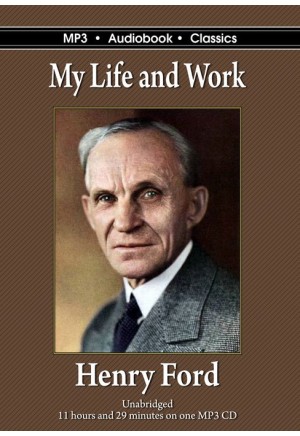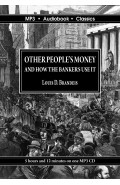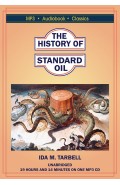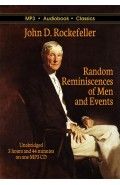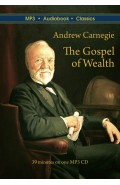| Track | Section | Length |
| 01 | 00 Introduction - What Is The Idea? | 48:25 |
| 02 | 01 The Beginning | 28:13 |
| 03 | 02 What I Learned About Business | 34:21 |
| 04 | 03 Starting The Real Business | 43:01 |
| 05 | 04 The Secret Of Manufacturing And Serving | 33:50 |
| 06 | 05 Getting Into Production | 32:47 |
| 07 | 06 Machines And Men | 30:08 |
| 08 | 07 The Terror Of The Machine | 32:37 |
| 09 | 08 Wages | 37:02 |
| 10 | 09 Why Not Always Have Good Business? | 24:44 |
| 11 | 10 How Cheaply Can Things Be Made? | 39:57 |
| 12 | 11 Money And Goods | 32:37 |
| 13 | 12 Money - Master Or Servant? | 35:49 |
| 14 | 13 Why Be Poor? | 27:29 |
| 15 | 14 The Tractor And Power Farming | 28:31 |
| 16 | 15 Why Charity? | 38:36 |
| 17 | 16 The Railroads | 28:51 |
| 18 | 17 Things In General | 45:38 |
| 19 | 18 Democracy And Industry | 31:41 |
| 20 | 19 What We May Expect | 34:45 |
- Download and read the eBook online at Gutenberg.org
- Download a PDF datasheet
Notes
Running Time:
Read by: LivelyHive
Book Coordinator: LivelyHive
Meta Coordinator: Laurie Anne Walden
Artwork
Cover: Cropped version of Henry Ford on the cover of Time Magazine, January 14, 1935. Photo credit: Jeffrey White Studios, Inc.
Insert background: The Ford Motor assembly plant in La Boca, Buenos Aires. 1921, La Nación newspaper.
Insert photo: 1910 Model T Ford, Salt Lake City, Utah. The photograph is for an advertisement, and taken by Harry Shipler of Shipler Commercial Photographers, April 11, 1910.
Recordings
These recordings were made using the author’s original published work, which is in the public domain. The readings were recorded by members and volunteers of Librivox.org, which has generously made the recordings available to the public domain. The audio files have been lightly edited and have been engineered using professional audio tools for maximum sonic quality. While Librivox condones the sale and distribution of these recordings, it is not associated with the management or operations of MP3 Audiobook Classics.
"My Life and Work" is an autobiography written by Henry Ford in conjunction with Samuel Crowther and published in 1922 when Ford was 59 years old. Ford was one of the great entrepreneurs and industrialists of the early 20th century, and the Ford Motor Company became one of the largest and most successful in the world, with a global reach and a huge impact on the landscape and culture as the automobile became an essential element in the American lifestyle. The book is a brilliant chronicle of the issues, ideas, innovations and impact of a legendary success story.
Henry Ford (July 30, 1863 – April 7, 1947) was an American industrialist who founded the Ford Motor Company. He was born the eldest of five on a farm in Michigan. He married Clara Bryant in 1888 and had one child, Edsel Ford, who succeeded his father as president of Ford in 1918.
He apprenticed as a machinist and then worked for Westinghouse and Edison as an engineer. He met Thomas Edison, who encouraged his experiments with gasoline engines and automobiles. He founded the Ford Motor Company in 1903. The Model T was introduced in 1908 supported by a huge publicity campaign. An inexpensive car that was simple to drive and easy to repair, it went on to sell 15 million units. By 1918 half of all the cars in America were Model T’s.
Ford was an inventor and innovator, earning 161 U.S. patents. Assembly line technology lowered costs and made the cars affordable to an emerging middle class. Paying top wages attracted the best workers, reduced turnover and enabled workers to buy the cars they made. Selling through independent dealerships cut selling expenses and made the dealers rich. The company was multinational, with ten subsidiaries on six continents selling a third of the world’s automobiles by 1932. The hallmarks of the company’s were often called “Fordism” and seen as a symbol of American culture.
Ford staunchly opposed labor unions, believing that labor leaders sought to restrict productivity gains to protect jobs. He capitulated only when a strike in 1941 brought things to a head. Ford threatened to close down but capitulated when his wife threatened to leave if he ruined the family business.
The Ford Motor Company was a vital government supplier during wartime, but Ford opposed war, thinking it wasteful. During World War I he supported Woodrow Wilson and the League of Nations. He believed that wars were encouraged by greedy financiers, mostly Jewish, who profited handsomely from conflict. During the 1920’s the company sponsored of the Dearborn Independent, a weekly paper that regularly published anti-Semitic articles. A libel suit in 1927 generated controversy that led to Ford’s denying any knowledge of the material, closing the paper and recanting his views in a public letter to the Anti-Defamation League.
Ford resumed control of Ford Motor Company after Edsel died in 1943. He turned the company over to his grandson Henry Ford II in 1945 and died in 1947. Much of his wealth went to establish the Ford Foundation. The Ford family continues to control the Ford Motor Company today.
Play sample:
Download a PDF datasheet
| Item Info | |
| EAN - DVD case | 0683422134852 |
| EAN - CD jacket | 0687700169659 |
| Media | MP3 CD |
| Package | DVD Case |
| Author | Henry Ford (1863 - 1947) with Samuel Crowther |
| Year | 1922 |
| Recording | |
| Read by | LivelyHive |
| Length | 11 hours and 29 minutes |
| Type of Reading | Solo |
My Life and Work
- Author: Henry Ford
- Product Code: DB-1166
- Availability: In Stock
-
$11.99
Available Options
Related Products
Other Peoples' Money and How The Bankers Use It
Other People’s Money and How the Bankers Use It is a collection of essays by Louis D. Brandeis that ..
$9.99
The History of the Standard Oil Company
The federal antitrust laws seek to provide balance in the relationship between consumers and corpora..
$11.99
The Education of Henry Adams
The Education of Henry Adams is listed as the number one non-fiction book in the English language by..
$11.99
Random Reminiscences
Random Reminiscences of Men and Events by John D. Rockefeller is a memoir of his activities in the o..
$9.99
Thoughts on Art and Life
At the age of 55 Leonard da Vinci set out to organize his ideas from a review of the thousands of pa..
$9.99
The Gospel of Wealth
Andrew Carnegie, an immigrant from Dunfermline, Scotland with only a grammar-school education, amass..
$7.99

